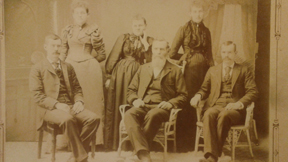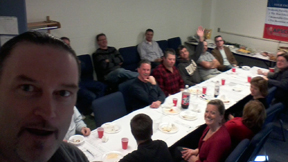What is Humor?

Humor is not simply something that is funny. There must be an element of intent, because humor is something that is tried, and either succeeds or fails. If it succeeds, then it is funny, it provokes a reaction, and it is indeed humor. If it fails, it's just sad.
Many scholars agree that humor is local. This means that the audience must be in close proximity when amusement is offered, and must have something in common with the provider. A shared miserable experience, such as work, offers an opportunity for palpable irony to exceed the threshold of indifference. The strength or weakness of this effect can be determined by the body language of the recipient.
Measuring the effect of humor is as much art as science. The outward indication is often visibly detectable as laughter, but it is often impossible to gauge the sincerity of this response. Factors such as relative socio-economic position can artificially enhance or suppress the response, resulting in false positive readings. Experiments have been proposed to mitigate this unpredictable influence, but for the foreseeable future the best measure will continue to be career retention.
Continue...History of Humor

The first attempt at workplace humor is said to have occured in 1392 in an alcove outside the Papal residence somewhere in southern France. Although the routine is generally recognized as the first official slapstick offering, the religious overtones disqualified it from any formal registration. The antics of the performer were so hilarious that a Bishop is said to have wet his cassock. Unfortunately, all records of the event were lost in a fire the following planting season, so nothing is known of the routine itself.
Modern day humor is well documented, but statistics regarding humor usage in the office vary. Humor occurs in all offices on at least a daily basis, but failed attempts are often masked by coughing or other bodily expressions, and may go unreported. Given these skewed results, and the fact that the science of humor is fairly new, it is no surprise that statistical modeling has little comparative data to consider. Strong estimates tend to support the conclusion that humor is statistically measurable within the margin of error.
Continue...The Modern Office

An office is essentially a centralized administrative gathering place that is functionally oriented, with some shared goal. This goal can be closely or loosely shared, but the various functions of the office inhabitants are designed to support this function. The specific duties of the individual inhabitants may be quite varied, and may even utilize unrelated skill sets. The most important characteristic of the office is that it generates output that helps to maintain the livelihood of the office inhabitants. In this regard, the office is a self-sustaining economic entity.
The cubicle is the primary productivity enhancement tool of the modern office. It evolved from a need to segregate human office workers, but in a way that maintained office proximity. This duality facilitates both individual effort, and group indoctrination. Although cubicle inhabitants may find the enclosed nature of the cubicle depressing and dehumanizing, corporate productivity has benefitted greatly from this organizational modality.
The typical office cubicle has four grey walls, no windows, and limited grazing room. Many cubicles can be fitted into a single, warehouse-like space, greatly improving office functionality. It is within this environment that office humor has the best chance to develop, but it is largely dependant upon the personalities of the inhabitants.
Office Personalities

There are three distinct office personalities. These are classified as the Stoic, the Follower, and the Humorist. Although from a psychological perspective all office workers have some combination of all three personalities, one is always dominant.
The Stoic is all about business. Even in the presence of certified humor, the Stoic will not crack a smile, as if he did not even hear the limerick that has everyone else in stitches. The bottom line is the bottom line. As long as the numbers all add up, there is nothing to laugh about. This is not to say that all Stoics are financial workers, but the numbers are what they are.
The Follower is happy to laugh at your joke, as long as everyone else does. Office celebrations are always well attended by Followers, and while Followers are seldom the first to adopt a new mission statement, they are never far behind. If a room is occupied only by Followers, either panic or paralysis will ensue. For this reason, management is always careful to organize groups with a mix of office types.
The Humorist is a paradox. Although quick-witted, the Humorist functions within a wide range of professional capability. At the lower end, the Humorist uses wit as a cover for incompetence. This can be exacerbated by a management penchant for enabling. Sometimes the need for humor is so overwhelming that a manager will overlook poor work performance in exchange for a quick laugh. At the upper range, a Humorist may be very competent, and may even rise to the top of their field. In this case, humor is used either as a release from the stress of performance, or is a simple byproduct of the good nature of the Humorist. It's really hard to tell.
Keys To Humor

Before you attempt any effort at humor, accept the possibility of failure. Sometimes what seems funny to you is not funny to others. Derisive stares will be the result. Try not to cry. As surely as toddlers stumble, jokes will fall flat, but pick yourself up and move on.
There are certain keys to success. First, know your audience. Presenting humor to an unknown group of humans is like door-to-door vacuum cleaner sales. Sure, you may get lucky, but the odds are just not in your favor. In the worst cases, everyone just ends up feeling uncomfortable. Second, try to make your humor topical to the group you are targeting, so that what you offer is relatable. This doesn't guarantee it will be funny, but at least it has a chance, kind of like trying to sell a vacuum cleaner to someone with a dirty floor. And no vacuum cleaner. And extra money.
The third key is to be timely. Sometimes this means being quick, and sometimes it means waiting for the right moment. In either case, timing is critical. So is spacing, as in finding room in the middle of the conversation to launch your humor. It can be tricky to put it all together.
Lastly, practice, practice, practice. This is especially important if you are not especially witty. Humor is important to any career path, as well as to social aspirations. Just because you can't think of anything funny doesn't mean you can't learn. And oh, what dividends!
Conclusion

Humor in the workplace is unavoidable, whether you are giving it or receiving it. Most workers try to be funny at some point, but sometimes it takes practice. Humor is a risk, but it can also have benefits, and many careers have been built or extended on little more than a joke and a prayer.
Office humor is a special example, and should incorporate the elements described above for the greatest hope of success. The only failure in the undertaking of humor is to not try at all, so by all means, at that next meeting, knock 'em silly!
About the Author

Welcome! My name is William R. Vitanyi, owner of Bayla Publishing. The books, apps, and articles on this site are my own, and I created Bayla Publishing, and this site, for their publication.
Why Bayla? In the early nineteen hundreds Bela Vitanyi passed through Ellis Island, and was asked his name. He responded "Bela" (pronounced "Bayla") which sounded like "Bill", so it was declared that his name would henceforth be Bill, short for William. Apparently he approved, naming one of his sons William, which started a family tradition of sorts.
In an homage to Bela, my grandfather, the intrepid soul who lost his name at Ellis Island, and to phonics, I named my company Bayla Publishing.
The Official Guide To Office Wellness
Numerous medical conditions affect office workers. Long periods of sitting leads to poor posture, staring at a monitor for hours on end causes eye strain, and repetitive commuting causes Carpool Tunnel Syndrome. Germs, poor air quality, stress, and work all contribute to office illness on a scale never before seen in human history.
Something funny had to be done.
In The Official Guide to Office Wellness, the job of the models was to pose in bizarre positions on, over, and in their desks and cubicles. Photographed in offices, and inspired by animals, these models showed that laughter and an awkward pose can go a long way towards improving office wellness. As they posed to be photographed, the complaints were frequent and familiar:
That hurts.
100 office workers pose on, over, and in their desks and cubicles to demonstrate animal-inspired techniques designed to alleviate office maladies. Features photography, Latin, and humor. Winner of an IPPY award for humor.
Connect with Bayla Publishing
Connect with William R. Vitanyi
Vitanyi
Follow @vitanyi
To contact the author send email to: Contact William R. Vitanyi
We are a participant in the Amazon Services LLC Associates Program, an affiliate advertising program designed to provide a means for us to earn fees by linking to Amazon.com and affiliated sites.

© 2021 Bayla Publishing LLC